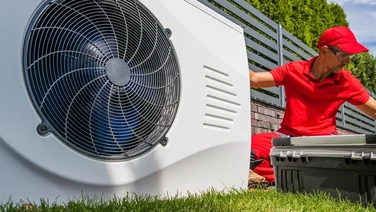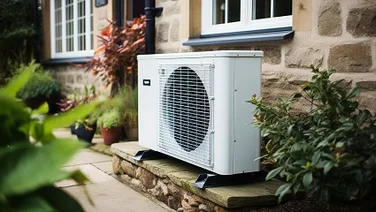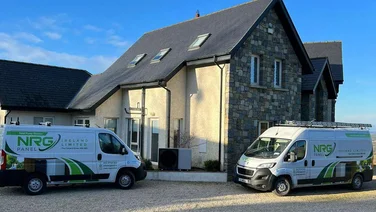- Short cycling can reduce the life of your heat pump
- A buffer cylinder can help reduce the risk of short cycling
- An unexpected spike in your energy bill can be a sign of short cycling
Heat pumps can save you money and reduce your carbon footprint, but like any other piece of equipment, problems can occur. When they do, you need know what action to take – particularly if you haven’t owned a heat pump before.
One common problem with heat pumps is short cycling, which can hurt your pump’s performance if it is not spotted and fixed early.
During normal operation, heat pumps are designed to turn off and on at intervals, in order to maintain the desired temperature.
Short cycling is when these cycles become very short over time, with the pump turning off and on every few minutes.
This can harm the efficiency and performance of your heat pump and can also be a sign of a larger issue.
If you’ve just bought a heat pump, or are planning to do so, this article will help you to spot and prevent short cycling.

Short cycling can harm the efficiency and performance of your heat pump
How often should a heat pump cycle?
Standard heat pumps use three interconnected operation cycles. In colder months, heating cycles extract thermal energy from the air or ground (depending on the type of pump you have) and transfer it indoors to warm your home.
In the warmer months, the heat pump draws heat out of the indoor air and sends it outside, cooling your home.
Heat pumps also generally have a defrost cycle. This is used to prevent damage to the pump by preventing ice from forming on the external coils.
The exact length of a heat pump cycle depends on a number of different factors.
These include the outside temperature, the room temperature, the amount of insulation, humidity, and the pump’s cooling or heating capacity. The cycle length can also change depending on the model of pump you have.
In general, most pumps will have two to three cycles per hour, with a 10 to 20 minute shutdown in between.
However, if the weather is especially cold for long periods, it is normal for the pump to run continuously or for longer periods in order to keep your home at a consistent temperature.
Short cycling is often described as a cycle that lasts for six minutes or less, but this is not a hard and fast rule.
Bean Beanland, director for growth and external affairs at the UK’s Heat Pump Federation, describes short cycling as “wasteful and inefficient” and says it “damages the longevity of the compressor.”
Warning signs of heat pump short cycling
Short cycling can be hard to spot, especially if you are a first-time heat pump owner and not monitoring it regularly. Warning signs can include:
- Strange noises from the heat pump
Loud or irregular noises coming from your heat pump can indicate a problem. These could include clicking or rattling noises during each on/off cycle or rapid changes in fan speeds.
- Uneven temperature distribution in your home:
One of the most obvious signs of short cycling is unusual or uneven temperature distribution in your home. This can take the form of hot spots, cool patches, or drafty areas in one or more rooms.
- An unexpected increase in your energy bill
There will be natural increases and decreases in your energy bill throughout the year. However, a sudden or unexpected increase in your bill could mean something is wrong.

Short cycling can cause a sudden increase in your heating bills.
The role of sizing in short cycling
As mentioned above, having the wrong size heat pump can affect performance and can lead to short cycling.
Quite simply, if the pump is too big for your home, it will need to turn on and off more frequently in order to maintain the correct flow temperatures in the radiators (or underfloor heating).
Beanland points out, however, that heat pump sizing is “also about controlling the way that heat pumps operate… most air source heat pump systems are now variable speed, so the compressor will ramp up and ramp down to heating demand of property.”
This means that if your system has a variable speed compressor, it will increase and decrease its cycling in relation to demand. In this case, having a pump that is a bit too big is not such a problem.
Do I need a buffer cylinder to prevent short cycling?
One way to avoid short cycling and make your heat pump more efficient is by using a buffer cylinder. This will add a bit more volume to the system.
A buffer cylinder is also known as a thermal storage tank or buffer tank. They are used with some heat pump systems. A buffer cylinder is essentially a water storage tank that serves as a thermal reservoir for the heating or cooling distribution system.
Having a buffer cylinder can help reduce cycling of air source heat pumps. It does this by storing excess energy (e.g. hot water) produced by the heat pump during periods of low demand and releasing it when demand is high. This reduces temperature fluctuations and so allows the heat pump to operate for longer periods at a consistent output.
Whether a heat pump system should have a buffer cylinder will depend a number of factors. These can include the specific design of the heating or cooling system, the characteristics of the building, and the demand.
Some types of heat pumps, such as inverter or variable-speed pumps, are designed to run continuously at variable speeds without the use of a buffer tank.
According to Beanland, when choosing what type and size of heat pump to install, it is important to first gain an understanding “about what you are trying to achieve, and then sizing everything appropriately to the outcome you are trying to achieve.”
Summary
- Short cycling is when a heat pump runs more than two or three cycles in an hour.
- Short cycling can be a sign that there is something wrong with your heat pump.
- Common causes of short cycling include an incorrectly sized pump, poor or no insulation, and equipment malfunctions.
- If your heat pump is cycling much more frequently than it should, you may want to have a technician come in and take a look at it.
- The best way to avoid short cycling is to make sure that your installer has correctly sized your heat pump before it is installed.
- For more information, see our article on heat pump sizing.







